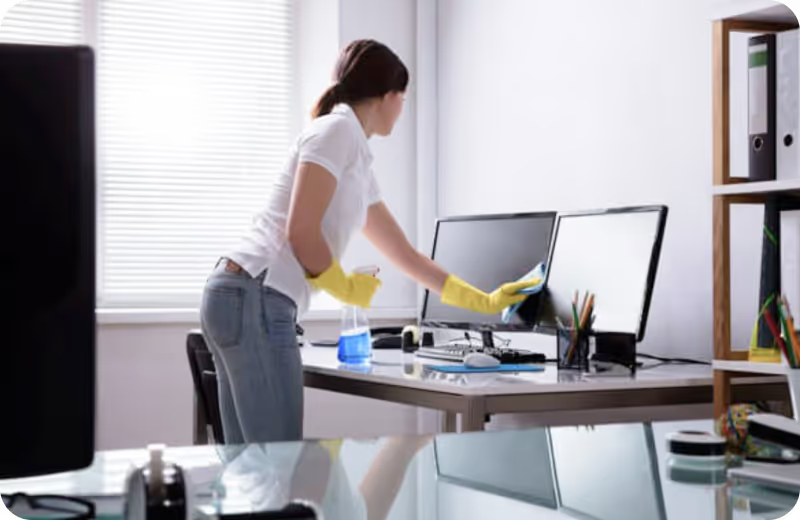
Common Problems with Delonghi Portable Air Conditioner
#1 Keeps Shutting Off
While Delonghi is known as a durable and long-lasting brand, one of the most common problems with their portable units is short cycling. This is when the air conditioner turns on and off more frequently than usual due to the drastic shortening of the cooling cycle. Here are some possible reasons why this may be happening:
- The cooling capacity of your portable air conditioner is too high for the size of the space it's cooling. When your AC cools the space too quickly, it reaches the thermostat’s set temperature faster than it should, causing the unit to shut off before completing its cooling cycle. And when the space warms up again quickly, your unit will turn back on, leaving it in a constant state of short cycling.
- Your portable air conditioner may have defective parts, such as a faulty compressor. Naturally, this will stop your portable air conditioner from functioning properly. The best thing to do is to have it checked by a professional HVAC technician.
- The inside of your portable air conditioner may be dirty. When certain components are left uncleaned for long periods of time, it can compromise the air circulation and overall cooling process, leaving you with an unsatisfactory cooling experience. To ensure that everything is thoroughly cleaned, book an appointment with an aircon cleaning and maintenance company.
#2 Smells Like Mildew
If you’re smelling a distinct and musty odor coming from your Delonghi portable AC unit, then you may have a mold or mildew problem on your hands. Since mold and mildew thrive in environments with excessive humidity, there may be an underlying problem inside your unit. Here are some possible causes:
- The air filter of your portable air conditioner may be dirty. If you don’t clean your air filter as often as you should, then it becomes blocked with dust, dirt, and debris. Over time, these impurities can absorb moisture and create the perfect environment for mold and mildew growth.
- The drain hose might need to be cleaned. The moisture produced by your AC is expelled through the drainage hose. However, this also offers mold and mildew the opportunity to grow inside. After disconnecting your drain hose, pour water through it to flush out any blockages. Then, pour equal parts white vinegar and water into the hose and let it sit for 15 minutes before rinsing everything thoroughly. This allows you to easily and effectively disinfect the inside of your hose to prevent future growth.
#3 Blowing Hot Air
If your Delonghi portable air conditioner is blowing warm or hot air instead of cool air, then there are a few reasons that may be behind this:
- The cooling capacity of your portable air conditioner may not be high enough for your space. Cooling capacity is often measured in British Thermal Units (BTU), with each square foot of space requiring around 20 BTU. Make sure that you keep this in mind when purchasing a new unit.
- Your portable air conditioner may not be set to cooling settings. Cooling mode allows your portable AC to sufficiently lower the temperature of your space, which is something that other modes like dry mode and fan mode can’t do. Aside from that, make sure to check that your unit is set to a low enough temperature to make the room cold.
- Components, such as the air filter and coils, of your unit may need to be cleaned. A dirty air filter restricts airflow inside your unit, while dirty coils compromise the heat absorption that’s crucial in the cooling process. Both of these can prevent your unit from performing properly, so make sure that you check and clean them regularly.
- Your portable air conditioner may have a refrigerant leak. Refrigerants play a massive role in removing the heat from the air, and a leak will prevent your AC from producing cool air. Have your portable unit regularly checked and inspected by a professional HVAC technician to make sure that everything is in tip-top shape.
#4 Leaking Water
There are a few reasons why your portable AC is leaking water:
- The drainage hose is clogged by dirt and debris. When the water can’t escape through the hose, then it finds its way back into your unit, resulting in an unwanted mess. Disconnect the hose and use a wet/dry vacuum to remove any blockages before flushing it with some soapy water to wash away any loose bits. You can also use a long and flexible brush to really scrub everything thoroughly before giving the hose a rinse.
- Your portable air conditioner may have a refrigerant leak. It’s very common to mistake a refrigerant leak for a regular water leak, but it’s actually much more serious and could come with further consequences and repercussions. Have it checked and inspected by a professional to keep your AC functioning properly.
- There may be ice buildup inside your unit. It’s very common for ice to form inside air conditioners, but you can expect a nasty leak once it eventually thaws. Take a look inside your air conditioner if you can to see if this is the case, then simply leave your unit powered off and let everything melt on its own.
#5 Ice Buildup
As mentioned before, it’s normal for portable air conditioners to have ice buildup, but here are a few common causes to know so that you can prevent it in the future:
- The air filters in your unit could be blocked by dust, dirt, and debris. This results in restricted airflow inside your unit, which can cause certain components to get too cold and freeze up. Make sure that you clean them regularly with some soapy water.
- Your unit might be running low on refrigerant or have a refrigerant leak. Regardless of the cause, low refrigerant levels can also compromise the temperature inside your unit and lead to ice formation, so have it regularly refilled by an HVAC technician.
- The coils of your air conditioner could also be covered in dirt. This prevents them from absorbing the heat from the air, which can result in them becoming too cold and freezing. Check and clean your coils as often as needed with a commercial coil cleaner, making sure to follow the instructions printed behind the product.
- There could also be high humidity and moisture levels inside your AC. Whether it’s from the weather or an issue with the drainage system, this leads to condensation on the coils, which may end up freezing when your unit is left running for long periods of time. It can help to leave a dehumidifier running along with your air conditioner.
Common Delonghi Error Codes
To give you a better understanding of what’s wrong with your air conditioner, your unit may show an error code that corresponds to a specific problem. You can check the LED display of your portable air conditioner to find the error code before consulting your owner’s manual to find its meaning. Here are some common error codes that you may encounter:
- LT: Frost prevention mode activated.
- H0: High temperature(heat mode) caused frequency to decrease.
- H1: Defrosting
- H2: Static dust eliminated protection.
- H3: Compressor overload protection.
- H4: System abnormality.
- H5: IPM Module protection.
- H6: No feedback from the indoor motor.
- H7: Synchronization failure.
- H8: Full of water protection.
- H9: Heater error.
- HC: PFC protection.
- HL: Delonghi portable AC internal tray full.
- CF: Delonghi portable AC filter is dirty.
- C2: Current leakage protection.
- C3: Wrong connection protection.
- C5: Jumper error protection.
- C6: No earthing.
- PF: Delonghi portable AC probe failure or sensor damaged.
- F0: Jam protection.
- F1: Indoor unit room sensor is disconnected.
- F2: Inverter module issue
- F3: Communication failure
- F4: Outdoor unit pipe sensor disconnected.
- F5: Outdoor unit delivery line sensor short-circuited/disconnected.
- F7: Oil circle under cooling mode.
- F8: Current overload caused frequency to decrease.
- F9: Exhaust overload caused frequency to decrease.
- FR: Tube temperature overload caused frequency to decrease.
- FH: Freezing caused frequency to decrease.
- E1: High pressure protection.
- E2: Defrost protection.
- E3: Low pressure protection.
- E4: Compressor gas discharge protection.
- E5: Current overload protection.
- E6: Communication malfunction.
- E7: MODE conflict.
- E8: High temperature protection.
- E9: Protection against cold air.
- LE: Frost protection
- HE: Compressor temperature too high
- HL: Safety tank is full
- PF: Sensor probe failure
How to Clean Delonghi Portable Air Conditioner
Follow these steps to clean your Delonghi portable air conditioner:
- After powering down and unplugging the unit, wipe down the outer body of your portable air conditioner with a damp cloth before wiping it dry with a clean cloth.
- Remove the air filter from the portable air conditioner and use a vacuum cleaner to remove any loose dirt and debris. Then, submerge it in some soapy water and gently scrub it with a sponge or brush if needed before letting it dry completely. Finally, reinstall it in the unit.
- At the end of each season, remove the external cap at the side of your portable air conditioner and let all the water from the circuit drain out into a plate or container. Replace the cap once it’s fully empty.
- If you want to have your Delonghi portable air conditioner deep cleaned, then book an appointment with an aircon cleaning and maintenance service.
Maintaining Your Delonghi Air Conditioner
The Delonghi air conditioner is known as a durable and efficient brand—but with the proper care and maintenance routine. Your air conditioner needs a maintenance schedule at least once every 4-6 months to keep it in good shape and to prevent any issues that come with a dirty, unkempt air conditioner.
Contact us today, and feel the difference with your clean air conditioner!










.jpeg)















